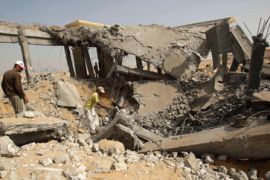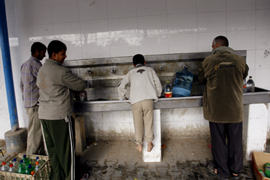Waiting in Gaza
An insight into life under blockade inside a 360 sq km piece of land.

 |
| Israel is not expected to ease the sea blockade of Gaza after its attack on the aid flotilla [EPA] |
The volatile situation in the Palestinian territories puts the Gaza Strip in the headlines frequently.
But despite the adversity behind these newsworthy events, there is nothing that Gazans fear more than dropping out of the headlines – the only real link to the outside world – and falling deeper into the isolation and obscurity of the Israeli blockade.
Gaza under siege is a forgotten place where time and change are irrelevant aside from degradation, both of physical surroundings and the quality inside us that makes human beings yearn for life.
What keeps it afloat is outside humanitarian aid, but what infuses it with that faint semblance to normalcy are the tunnels running between Gaza and Egypt.
Covert and basic only two years ago, tunnel trade increased as the blockade continued.
The not so distant memory of the fuel crisis, when hospitals shut down and cars ran on diesel mixed with cooking oil, is what led more traders to go underground.
Today, store shelves are no longer empty, and pharmacies carry more types of medication.
Today electrical appliances can be brought in from Egypt, and power cuts have gone down to eight hours a day.
For many Gazans this is a far cry from the conditions they have endured since as far back as 2005.
But contrary to recent Israeli propaganda claims, in Gaza poverty, destitution and inhumane conditions not only exist, but thrive.
Perpetual state of waiting
The majority of Gazans, those at the market surveying goods, strolling around town (no one walks fast in Gaza, few people have pressing business) or lounging idly on chairs outside stores, are in a perpetual state of “waiting”.
Ask any person what their future plans are, or – in the 50 per cent likelihood that they are unemployed – when they plan on getting a job, and you will get the same answer: when things get better I will know.
With a 70 per cent poverty rate it is not uncommon for young children to survive on a diet of bread, yogurt and water, as the majority cannot afford the products in the market.
In some stores these products are past their expiry dates, but still sit on the shelves.
 |
| Water resources in Gaza are either scarce or contaminated [GALLO/GETTY] |
With the damage to the infrastructure, Gazans have to buy clean drinking water.
I have been in homes where families with children have had to borrow money to buy clean water or go without.
I have also been in neighbourhoods where children suffer from skin and respiratory diseases from the sewage water that is dumped into the environment.
While thousands of young Gazans graduate from collage each year, less than half of them stand a chance of getting a job.
In some areas in Gaza ruins of bombed buildings have become landmarks, and in other areas the buildings that remain standing look odd amid the ruins.
Everything, from electronics to stationary is low quality and overpriced. People no longer see shame in wearing patched clothes.
If you get a serious illness you will probably go untreated and most likely not be allowed to leave for treatment, and if you live you are lucky.
Diminishing expectations
Years of imprisonment within a 360 square km piece of land, surrounded on all sides by a hostile military presence changes you, as an individual and as a people.
It diminishes your ability to expect good things, for yourself and from yourself.
There is no talk of the future any more in Gaza.
Under the current conditions most people live day to day on just enough knowing that they may not have even that tomorrow.
Palestinian leaderships in Gaza and the West Bank are ineffective in the face of Israel, and the rift between them is so wide that unity is as unlikely as the revival of the peace process.
Faith in international diplomatic efforts has all but disappeared.
Many American, European, Arab and UN officials at the highest levels have come to look at Gaza after the offensive.
They take the tour, visiting the sites of destruction, meet with representatives of the Palestinian factions, give a speech pledging solidarity and promising an end to the collective punishment that is the blockade.
These visits no longer raise hopes among Palestinians, or draw criticism from Israel, as both sides have come to understand that they are both fruitless (for Gazans) and inconsequential (to Israel).
Understanding the past
Do not believe news reports that tell you that Israel has eased the blockade.
Allowing cookies, pasta and stationary to enter the strip after they had been banned is not exactly addressing the humanitarian needs of a devastated, broken, poverty ridden, hungry, captive population.
The saying goes that to know the future you must understand the past.
It would all fall into perspective if it was acknowledged that Gaza has been under Israeli occupation since 1967, and remains so.
Previous peace agreements were a light version of this very occupation, granting Israel full control of the territory and its people and leading to the situation we are in today.
The views expressed in this article are the author’s own and do not necessarily reflect Al Jazeera’s editorial policy.